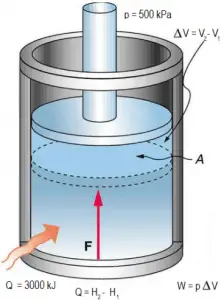Moreover, when we confine gases at lower densities, the differences tend to disappear. It was found, such gases tend to obey the following relation, which is known as the ideal gas law:
pV = nRT
where:
p is the absolute pressure of the gas
n is the amount of substance
T is the absolute temperature
V is the volume
R is the ideal, or universal, gas constant, equal to the product of the Boltzmann constant and the Avogadro constant. The power of the ideal gas law is in its simplicity. When any two thermodynamic variables, p, v, and T, are given, the third can easily be found.
The ideal gas model is based on the following assumptions:
- The pressure, volume, and temperature of an ideal gas obey the ideal gas law.
- The specific internal energy is only a function of the temperature: u = u(T).
- The molar mass of an ideal gas is identical to the molar mass of the real substance.
- The specific heats — cp and cv — are independent of temperature, which means constants.
From the microscopic point of view, it is based on these assumptions:
- The molecules of the gas are small, hard spheres.
- The only forces between the gas molecules are those that determine the point-like collisions.
- All collisions are elastic, and all motion is frictionless.
- The average distance between molecules is much larger than the size of the molecules.
- The molecules are moving in random directions.
- There is no other attractive or repulsive force between these molecules.
Validity of Ideal Gas Law
Since ideal gas is defined as one in which all collisions between atoms or molecules are perfectly elastic. There are no intermolecular attractive forces, and there is no such thing in nature as a truly ideal gas. On the other hand, all real gases approach the ideal state at low pressures (densities). At low pressures, molecules are far enough apart that they do not interact with one another.
In other words, the Ideal Gas Law is accurate only at relatively low pressures (relative to the critical pressure pcr) and high temperatures (relative to the critical temperature Tcr). At these parameters, the compressibility factor, Z = pv / RT, is approximately 1. The compressibility factor is used to account for deviation from the ideal situation. This correction factor is dependent on pressure and temperature for each gas considered.
